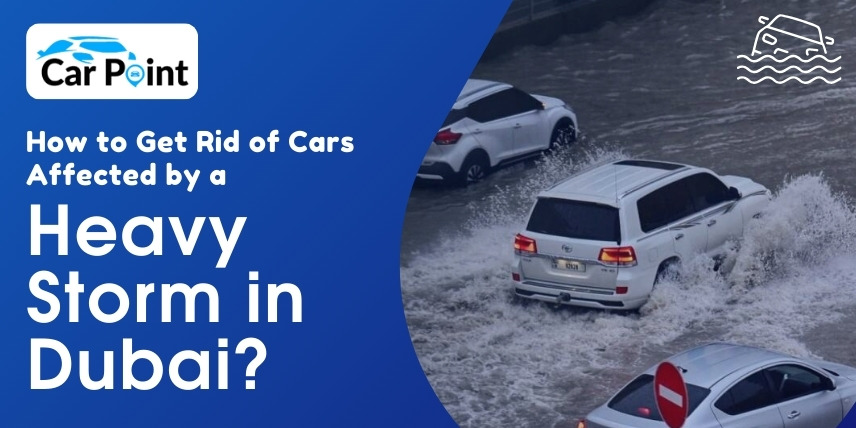
How to Get Rid of Cars Affected by a Heavy Storm in Dubai?
Following a strong storm in Dubai, many vehicle owners may find themselves faced with the difficult task of handling damaged cars caused by floods or other storm-related issues. At CarPoint, we recognize the difficulties people encounter when attempting to properly and efficiently get rid of their storm-damaged cars.
Whether your car has been damaged by flooding or other weather-related hazards, knowing how to dispose of it might be difficult. We offer thorough explanations and practical advice in this guide to help you dispose of and manage cars damaged by strong storms in Dubai. Allow CarPoint to be your reliable partner as you navigate this difficult road, from comprehending insurance coverage to investigating disposal choices.
Intense downpours, swiftly melting snow, escalating rivers, and breaches in levees or dikes can result in flooding of vehicles and necessitate intricate and costly auto repairs. It might be necessary to disassemble the entire car to clean it after the floodwaters reach the apertures in the doors. Never try starting a flood-damaged car until a professional mechanic has done a full vehicle inspection to prevent creating more issues.
The expense of fixing flood damage might easily surpass the worth of an automobile, depending on the year, make, and model of the vehicle. The first thing you should do after dealing with a flood-damaged car is call your insurance provider (assuming you have comprehensive coverage) to get advice on what to do.
Apart from the apparent harm it causes to carpets and upholstery, floodwater is a caustic and abrasive concoction of dirt and water that seeps into all the cracks and crevices in a car. Floodwater may also contain sewage and chemical pollutants, and salt water from ocean storm surges can increase the risk of car damage and expensive auto repairs in coastal areas.
It might not be a good idea for you to drive a car even though it is safe to do so mechanically due to health issues.

What To Search For About Cars Affected By a Heavy Storm in Dubai?
When a car has been in a flood, the drivetrain, engine, gasoline, braking, and power steering systems are the obvious places to be concerned about. Increased wear and early failure may occur if impurities are not eliminated from these crucial parts.
Modern automobile electrical systems are especially vulnerable to floodwater damage. It can be extremely difficult to salvage engine control computers, car sensors, infotainment systems, and other electronic equipment, together with wiring harnesses and the numerous connectors that connect them all. If all components are not completely cleaned and dried, corrosion-related issues may surface for weeks or even months following the flood.
A car's hard-to-reach parts make many of them difficult to clean and dry. Tucked away in enclosed spaces or up beneath the dash are door locks, window regulators, power seat motors, heating and air conditioning components, and many more small pieces. After a flood, these things might function OK at first, but later on, because of contaminated water, they might stop working.
Three things are necessary for a competent technician to complete before trying to start an automobile that has been flooded:
- Check for water contamination in mechanical parts and systems that hold fluids.
- Floodwater should be drained from contaminated parts and systems, cleaned with clean water or the suitable solvent, and refilled with the correct fresh fluids.
- Examine, tidy, and dehydrate the connections and parts of the electrical system.
Autos With Titles for Salvage
Insurance companies frequently "total" flood-damaged cars and auction them off. Some of these cars are bought by people who, with varied degrees of skill, restore them to working order and resale them to unwary car buyers rather than being disassembled for pieces by salvage firms.
A totaled car that has been damaged by flooding should have a "salvage" title; nevertheless, some vendors take advantage of loose registration laws in some jurisdictions to "launder" titles and remove the salvage marking.
Additionally, buyers should be aware that automobiles with flood damage can be exported anywhere for resale and that they will still be available for purchase for several months after significant flooding.
The best defense against purchasing a car that has been flooded is a comprehensive pre-purchase check performed by a reputable shop. The store will search for typical signs of water damage, like:
- Musty and moist smells.
- Recently cleaned or replaced carpet and upholstery.
- Mud and dried excrement beneath the dashboard, within the engine compartment, and within the trunk's body cavities.
- Corrosion or rust inside electrical connectors and on the body.
Additionally, some potential purchasers advise getting a vehicle history report. Even though these reports aren't perfect, they typically reveal when a car has received a salvage title, which is a sign that it has had serious issues in the past.
Conclusion
In conclusion, handling vehicles damaged by a strong storm in Dubai necessitates thoughtful deliberation and prompt response. We at CarPoint are dedicated to being there for you at every turn.
Whether you want to sell, fix, or get rid of your storm-damaged car, our staff can offer professional advice and support that is catered to your requirements. Don't allow a storm's aftermath to depress you. With CarPoint.ae at your side, take charge of the circumstance right now.
Are you prepared to move forward? Get in touch with us right now to find out more about our offerings and how we can assist you in safely and effectively disposing of your storm-damaged vehicle. Let's go confidently through this difficult period together.

